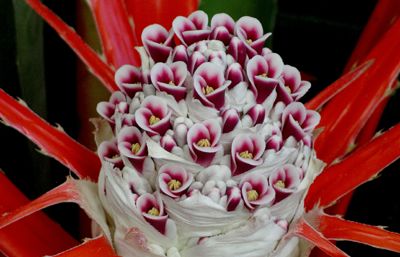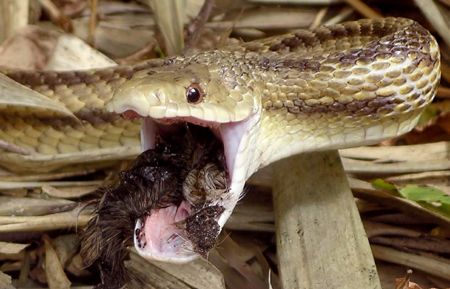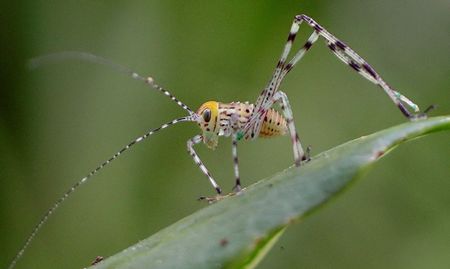
bromeliad inflorescence
Over the past few decades, I've visited a number of public gardens in a variety of states: Illinois, Florida, Georgia, Colorado, Missouri, California, and Texas. Here in Austin, I volunteered in the Hartman Prehistoric Garden, a section of Zilker Botanical Garden, for about four years. After that, I started regularly photographing at the Lady Bird Johnson Wildflower Center, eventually becoming a volunteer and then initiating and leading the Fauna Project, which, now wrapping up its 9th year, continues to this day.
Because plants depend on the climate and soil in which they grow, each garden is uniquely adapted to its location. Whether natives or exotics, the flora must be able to survive the conditions, so gardens in different areas are, well, inherently different from each other. It's sort of obvious that there are only a few places in our country where a garden can be a jungle. The combined requisites of plentiful moisture and lack of freezing temperatures rule out just about everywhere except a couple of choice spots. The same is true for desert, high altitude, or wetland habitats.
 bromeliad inflorescence |
At this point, I must admit that what captivates me personally is not necessarily the same thing that draws everyone. Many people like a garden that is a visual showpiece, with stunning large beds of color-coordinated blooms, cleverly manicured shrubs or flawlessly symmetrical arrangements that provide a perfect photo op. I do appreciate these things too, but they don't hold my interest for more than a short, breathtaking moment. Once I've seen it, well, I've seen it. Closer inspection does not bring further surprises or insights.
My characterization of a truly great botanical garden includes diversity, locally unique plants, and a design that encourages one to stay for the entire day. Size is not really as important as a layout that promotes the exploration of every nook and cranny, while compelling visitors to anticipate what might be in store around the next corner. It should be possible to "tour" the garden in a rather logical way that allows a first time guest to stroll through and see most of the highlights without getting too lost, while also giving regulars enough detours that they will never tire of their experience, no matter how many times they've wandered the same trails.
As far as I am concerned, one other thing that is an essential factor in any garden is its relationship to the resident animals. Plants are just one layer of the food web, and a healthy ecosystem (which, hopefully, a garden represents) does not keep energy artificially confined within that single stratum. One of my favorite quotes is "A plant that hasn't fed an animal is simply not doing its job." Nothing could be more true! This doesn't mean, of course, that large grazing animals should be allowed to wander through the plants, eating them to the ground. That would, at the very least, be extremely unsustainable. The vast majority of wildlife, especially on smaller tracts of land, consists of invertebrates, arthropods in particular, and they are mostly very tiny. It's sort of funny, but many people think of animals only as deer, songbirds, and lizards, while relegating insects and spiders to the level of annoying pests worthy only of swatting or stomping. A butterfly, beetle, or wasp is an animal too, and subsequently a member of the biome within a garden. Every animal living within the property depends upon the plants for food, and there is often a good deal of reciprocal interaction as well (think: pollination).
 Yellow Rat Snake eating a piece of old mammal pelt |
I discovered one of the best gardens I've ever encountered back in the mid-1990s. My parents had retired from the Chicago area to Ocala, FL, in 1992. I'd traveled around the state at various times prior to that, and lived in Tallahassee while attending college, but having family in residence gave me the opportunity to return to the area on a regular basis. Along with such favorite destinations as Silver Springs, Paynes Prairie, the Ocala National Forest, and the Florida Museum of Natural History, as we investigated the offerings we quickly found Kanapaha Gardens suitable for nature nerds. From the outset, it was obvious that this was a garden worthy of prolonged examination and repeat visits.
The early visits to Kanapaha were marked by the amusing difficulty we had actually finding the entrance, as there were almost no signs, and the road to it was barely better than a private drive discreetly leaving the main thoroughfare. The access station was an overgrown little shack where we happily paid the entry fee (about $5, I recall). The gardens, though, were absolutely fascinating. It was like wandering through an enchanted forest, with a friendly, attractive brick and cement walkway that guided us through a series of themed plots, twisting and turning around small grottos and hidden groves. Lush vegetation included both unusual foreign species and cultivars almost seamlessly blended with the native weeds. Those early trips began at least 20 years ago, and the passage of time has blended various highlights together. I recall finding a bat roosting on a bamboo stalk, seeing skinks slither across the path, marveling at the fine detail of unusual ferns and carnivorous plants, and enjoying the intricate design of the brick-walled herb garden.
There never seemed to be many people tending the garden, but it was obvious that an extraordinary amount of work had gone into it all. I occasionally chatted with a volunteer, gardener, or fellow guest without ever thinking about whether there were employees about or not. There were also never very many other visitors. Through the years, my family stays in Ocala occurred within different months, often around the winter holidays but sometimes in other seasons as well. During that period I took up digital photography and started recording plants, fungi, insects, and other small wildlife. I never missed a chance to visit Kanapaha.
Sometime around 2003 or so, I heard about an alligator attack on a gardener as he worked. I assumed it happened down by the large Lake Kanapaha and I vaguely remember that the pathway leading down to the lake was closed about then, presumably to keep people away from the potentially dangerous site. I was quite familiar with alligator behavior because I'd been kayaking around them since the 1970s, and I imagined that somebody had been quite careless to have put himself in harm's way.
As the years and visits continued, I was enchanted by the development and construction of the Children's Garden near the large water-reclamation feature, saddened by the demise of the three-crowned palm, and never failed to find mesmerizing insects, reptiles and amphibians to document. At various times, the trilliums, arums, thunbergia, bamboos, Victoria water lilies, and innumerable other plants put on stunning displays. Sometimes it rained, sometimes it was bitterly cold, sometimes we almost passed out from the heat, and, believe it or not, sometimes the weather was perfect. I loved every outing.
On a recent foray into what has by now become a rather familiar destination, I saw a man adding plants to the Children's Garden. I felt I just had to tell him how much I appreciated Kanapaha and thank him for his contributions to its upkeep. As we started up a conversation, I noticed he was missing an arm, which meant he was the victim of the alligator attack. That passing thought was quickly lost in favor of an engaging exchange as we discussed all manner of topics, from gardening in our respective states, to insects, educating the public about ecology and animal behavior. I love chatting with intelligent people, and this man was both knowledgeable and inquisitive. A half-hour breezed by, and I deemed it prudent to allow him to return with his work while I continued on the walk with my mother, who was patiently waiting nearby.
 Giant Katydid nymph |
My expectations were not the highest, as, though I know some excellent science writers, there are also some exceedingly competent naturalists for whom writing is more an afterthought than a serious passion. They might have good stories, but the finer points of producing a coherent and fluid essay will forever elude them. But my money was well spent; the chapters of this little paperback were fluent and compelling, with judicial use of humor and detail. Of course I read about the alligator attack and learned the real facts surrounding the entire episode (quite different from what I'd imagined - and absolutely terrifying). I wanted to just sit and read the whole book, but instead offered it to my mom, who was definitely delighted with the gift. By now, both my sister and I own copies, as my mother correctly assumed we also would enjoy reading it.
One of the most illuminating chapters was about the beginnings of the garden. As much as I liked Kanapaha Botanical Gardens before reading its story, the insights about the remarkable person who, along with his wife, created it and maintains it to this day, increased my respect on several levels. On one hand, the chronicle of the garden reveals a long and arduous journey that has resulted in a fabulous public treasure, while, on the other, it is obvious that the thoughtful and many-faceted personality of the director is one of the main factors shaping the entire landscape. I'd never thought about it in such detail before, but the human influence can be a force almost equal to climate and geology when it comes to guiding a garden into its current state. And perhaps the best leadership results in the most subtle effects on the outcome.